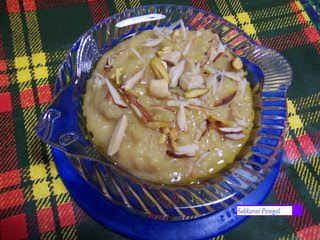Mixture
Snack that is a Mix of 4 to 5 items.
South Indian style Mixture is presented below.
South Indian style Mixture is presented below.
 For that you need:
For that you need:1. Kara Boondhi - 2 cups [Method given below]
2. Oma Podi - 2 cups [Method given below]
3. Fried Thick Aval (Poha) - 2 cups
4. Ground Nuts - 1/2 cup
5. Chutney Dal - 1/2 cup (Pottukkadalai)
6. Cashew Nuts - 1/4 cup
7. Curry leaves - 2 Sprigs
Items for Mixture Masala.
1. Dry Red Chillies 6 to 7
2. Hing
3. Salt
4. Sugar
5. Ghee 1 tsp
Making of the Boondhi
1. Besan - 3/4 cup
2. Rice flour - 1 tsp
3. Salt to taste
4. Chilli Powder to taste
5. Oil tsp
6. Water
Method:
1. Sieve the flour and add Salt, Chilli Powder, Oil and make it to Bajji Batter Consistency with water.
2. Heat Oil in a Kadai, make Boondhi with Boondhi laddle.
3. Drain Oil and Keep it aside.
Boondhi Making refer here.
Making of the OmaPodi
1. Besan - 1 cup
2. Rice flour - 1/4 cup
3. Salt to taste
4. Chilli powder
5. Finely crushed Omum (Ajwain) or Omum Water
6. Water
7. Ghee or Hot Oil - 1 tsp
Method:
1. Mix everything Chappathi dough consistency.
2. In a Kadai squeeze Omapodi direct into the oil using Murukku or Omapodi press.
3. Drain and Keep it aside.
Making of the Mixture:-
1. Deep fry Aval (Thick poha) in Oil, drain and keep it aside.
2. Deep fry Cashew nuts, Ground nuts, Chutney dal and keep it aside.
3. In same Oil fry curry leaves. (be careful)
Mixture Masala:-
In small kadai or in same oil deep fry Red chilli and grind into powder along with
Salt, Hing and Sugar.
Mix everything in a Container or Paper and on top of it add mixture Masala .
On top of mixture Masala add one tsp of Hot Ghee and Mix with both hands.
Till masala coats to everything.
Store in an air tight container and you can use it for even a month.
Enjoy the festival time Snack with family and friends or even while watching TV.
















